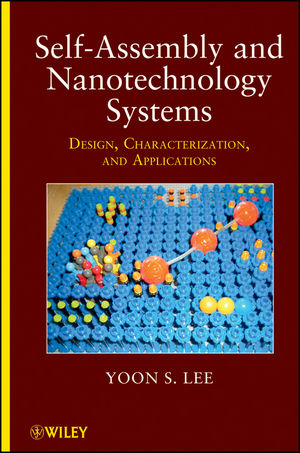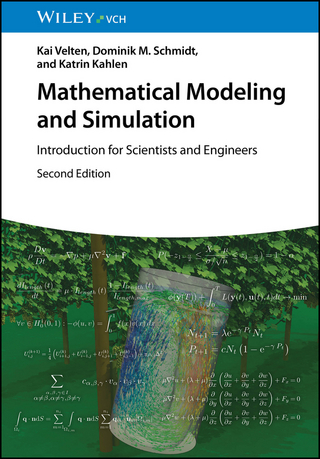
Self-Assembly and Nanotechnology Systems
John Wiley & Sons Inc (Verlag)
978-1-118-08759-6 (ISBN)
A fundamental resource for understanding and developing effective self-assembly and nanotechnology systems
Systematically integrating self-assembly, nanoassembly, and nanofabrication into one easy-to-use source, Self-Assembly and Nanotechnology Systems effectively helps students, professors, and researchers comprehend and develop applicable techniques for use in the field. Through case studies, countless examples, clear questions, and general applications, this book provides experiment-oriented techniques for designing, applying, and characterizing self-assembly and nanotechnology systems.
Self-Assembly and Nanotechnology Systems includes:
Techniques for identifying assembly building units
Practical assembly methods to focus on when developing nanomaterials, nanostructures, nanoproperties, nanofabricated systems, and nanomechanics
Algorithmic diagrams in each chapter for a general overview
Schematics designed to link assembly principles with actual systems
Hands-on lab activities
This informative reference also analyzes the diverse origins and structures of assembly building units, segmental analysis, and selection of assembly principles, methods, characterization techniques, and predictive models. Complementing the author's previous conceptually based book on this topic, Self-Assembly and Nanotechnology Systems is a practical guide that grants practitioners not only the skills to properly analyze assembly building units but also how to work with applications to exercise and develop their knowledge of this rapidly advancing scientific field.
YOON S. LEE, PhD, is a Scientific Information Analyst at Chemical Abstracts Service. He earned his PhD from Seoul National University in South Korea and performed postdoctoral research at The Ohio State University. He is the author of Self-Assembly and Nanotechnology: A Force Balance Approach.
PREFACE xvii ABBREVIATIONS xix
PART I BUILDING UNITS 1
1 Self-Assembly Systems 3
1.1. Self-Assembly / 4
1.2. Identification of Building Units / 6
1.2.1. What Is a Self-Assembly Building Unit? / 6
1.2.2. Segmental Analysis / 7
1.2.2.1. Three Fundamental Segments / 7
1.2.2.2. Two Additional Segments / 11
1.3. Implication of Building Unit Structures for Self-Assemblies / 15
1.4. General Assembly Diagram / 17
1.5. Collection of Building Units / 23
1.5.1. Basic Building Units / 23
1.5.2. Directionally Assembling Building Units / 26
1.5.3. Asymmetrically Packing Building Units / 28
1.5.4. Functional Building Units / 28
1.6. Concluding Remarks / 30
References / 31
2 Nanotechnology Systems 33
2.1. Nanoassembly / 35
2.2. Identification of Building Units / 37
2.2.1. What Is a Nanoassembly Building Unit? / 37
2.2.2. Fabrication Building Units / 38
2.2.3. Reactive Building Units / 40
2.3. Nanoelements / 41
2.4. Implication of Building Unit Structures for Nanoassemblies / 42
2.5. General Assembly Diagram / 45
2.6. Self-Assembly, Nanoassembly, and Nanofabrication / 51
2.7. Collection of Building Units / 54
2.7.1. Ligand-Protected Nanoparticles / 54
2.7.2. Functional Surfaces / 56
2.7.3. Reactive Precursors / 57
2.7.4. Substrates / 57
2.7.5. Reducing Agents / 58
2.8. Concluding Remarks / 58
References / 60
PART II DESIGN 61
3 Identification of Self-Assembly Capability 63
3.1. Assembly Issue / 63
3.2. General Overview / 64
3.3. Assembly Principles / 65
3.3.1. Molecular Self-Assembly / 65
3.3.1.1. Ionic Surfactants / 69
3.3.1.2. Nonionic Surfactants / 70
3.3.2. Colloidal Self-Assembly / 71
3.3.2.1. Colloids with Different Origins / 74
3.3.2.2. Colloids with Different Sizes / 75
3.3.3. Directionally Assembling Systems / 77
3.3.4. Self-Assembly at Surfaces / 81
3.3.4.1. Hydrophobic Surfaces / 82
3.3.4.2. Hydrophilic Surfaces / 87
3.4. Collection of Primary Self-Assembled Aggregates / 89
3.5. Summary / 89
References / 91
4 Identification of Multi-Step Self-Assemblies 93
4.1. Assembly Issue / 93
4.2. General Overview / 94
4.3. Assembly Principles / 96
4.3.1. Molecular Self-Assembly of Surfactants / 97
4.3.2. Colloidal Self-Assembly / 102
4.4. Collection of Higher-Order Self-Assembled Aggregates / 105
4.5. Collection of Self-Assembled Aggregates within Biological Systems / 107
4.6. Summary / 108
References / 110
5 Control of the Structures of Self-Assembled Aggregates 111
5.1. Assembly Issue / 111
5.2. General Overview / 112
5.2.1. Primary Self-Assembled Aggregates / 112
5.2.2. Higher-Order Self-Assembled Aggregates / 113
5.3. Assembly Principles / 115
5.3.1. Primary Self-Assembled Aggregates / 115
5.3.1.1. Molecular Systems I / 117
5.3.1.2. Molecular Systems II / 121
5.3.1.3. Colloidal Systems / 125
5.3.2. Higher-Order Self-Assembled Aggregates / 130
5.3.2.1. Molecular Systems / 132
5.3.2.2. Colloidal Systems / 134
5.4. Collection of the Structures of Self-Assembled Aggregates / 136
5.4.1. Primary Self-Assembled Aggregates / 136
5.4.2. Higher-Order Self-Assembled Aggregates / 137
5.5. Summary / 139
References / 140
6 Hierarchy and Chirality of Self-Assembled Aggregates 141
6.1. Assembly Issue / 141
6.2. General Overview / 142
6.3. Assembly Principles / 143
6.3.1. Molecular Systems / 145
6.3.2. Surface Systems / 148
6.4. Collection of Hierarchy within Self-Assembled Aggregates / 156
6.5. Collection of Chirality Expressed by Self-Assembled Aggregates / 157
6.6. Summary / 159
References / 160
7 Assembly with Multiple Building Units 161
7.1. Assembly Issue / 161
7.2. General Overview / 163
7.3. Assembly Principles / 164
7.3.1. Analysis of Building Units / 164
7.3.2. Assembly of Nanoassembled Systems / 168
7.3.2.1. Homogeneous Assemblies / 168
7.3.2.2. Sequential Assemblies / 172
7.3.2.3. Hierarchical Assemblies / 177
7.3.3. General Assembly Trends / 180
7.3.3.1. Homogeneous Assemblies / 180
7.3.3.2. Heterogeneous Assemblies I / 182
7.3.3.3. Surface Assemblies / 183
7.3.3.4. Heterogeneous Assemblies II / 184
7.4. Collection of Nanoassembled Systems I / 185
7.5. Collection of Nanoporous Solids / 186
7.5.1. Synthetic Zeolites / 187
7.5.2. Metal-Organic Frameworks / 189
7.6. Summary / 189
References / 189
8 Directed and Forced Assemblies 191
8.1. Assembly Issue / 191
8.2. General Overview / 192
8.3. Assembly Principles / 196
8.3.1. Analysis of Building Units / 196
8.3.2. Assembly under External Forces / 199
8.3.2.1. Forced Assemblies / 199
8.3.2.2. Directed/Forced Assemblies / 204
8.3.2.3. Directed Assemblies / 208
8.3.3. General Assembly Trends under External Forces / 213
8.3.3.1. Forced Assemblies / 214
8.3.3.2. Directed/Forced Assemblies / 215
8.3.3.3. Directed Assemblies / 216
8.3.3.4. Window of Critical External Forces / 218
8.4. Techniques for Directed and Forced Assemblies / 219
8.5. Surface-Induced Directed and Forced Assemblies / 220
8.6. Collection of Nanoassembled Systems II / 220
8.7. Summary / 222
References / 222
PART III APPLICATIONS 225
9 External Signal–Responsive Nanomaterials 227
9.1. Nanoissue / 227
9.2. General Overview / 228
9.3. Assembly Principles / 231
9.3.1. External Signal–Responsive Molecular Assemblies / 231
9.3.1.1. Light-Responsive Assemblies / 232
9.3.1.2. Catalytic Reaction–Responsive Assemblies / 235
9.3.1.3. Electrochemical-Responsive Assemblies / 237
9.3.1.4. Solution pH–Responsive Assemblies / 239
9.3.2. External Signal–Responsive Colloidal Assemblies / 242
9.3.2.1. Thermo-Responsive Assemblies / 244
9.3.2.2. Solution pH–Responsive Assemblies / 245
9.3.2.3. Magnetic Field–Responsive Assemblies / 247
9.4. Collection of External Signal–Responsive Assembly Systems / 250
9.5. From Assembly Systems to Nanomaterials / 250
9.6. Collection of External Signal–Responsive Nanomaterials / 253
9.7. Summary / 254
References / 255
10 Nanomaterials with Intrinsic Functionalities 257
10.1. Nanoissue / 257
10.2. General Overview / 258
10.3. Assembly Principles / 261
10.3.1. Molecular Assembled Systems / 263
10.3.2. Colloidal Assembled Systems / 267
10.4. From Assembled Systems to Nanomaterials / 270
10.5. Collection of Nanomaterials with Intrinsic Functionalities / 270
10.6. Summary / 272
References / 272
11 Nanostructures: Designed to Perform 275
11.1. Nanoissue / 275
11.2. General Overview / 276
11.3. Assembly Principles / 277
11.3.1. Analysis of Building Units / 277
11.3.2. Nanostructure Assemblies / 281
11.3.3. Nanopore-Based Nanostructures / 283
11.3.4. Nanoparticle-Based Nanostructures / 287
11.3.5. Nanofilm-Based Nanostructures / 292
11.3.6. General Trends / 297
11.4. Collection of Common Nanostructure Names / 298
11.5. Collection of Nanostructures and Their Applications / 298
11.6. Summary / 301
References / 303
12 Nanoproperties: Controlled to Express 305
12.1. Nanoissue / 305
12.2. General Overview / 306
12.3. Assembly Principles / 307
12.3.1. Analysis of Building Units / 307
12.3.2. Different Types of Nanoproperties / 313
12.3.3. Assemblies to Obtain Nanoproperties / 316
12.3.4. Individual Types of Nanoproperties / 318
12.3.5. Collective Types of Nanoproperties / 321
12.3.6. Cooperative Types of Nanoproperties / 324
12.3.7. General Trends / 327
12.4. Collection of Nanoproperties and Their Applications / 328
12.5. Summary / 329
References / 331
13 Nanofabricated Systems: Combined to Function 333
13.1. Nanoissue / 333
13.2. General Overview / 334
13.3. Fabrication Principles / 335
13.3.1. Analysis of Building Units / 336
13.3.2. Nanofabrication / 340
13.3.3. Bottom-Up Approach / 342
13.3.4. Top-Down Approach / 345
13.3.5. Bottom-Up/Top-Down Hybrid Approach / 347
13.3.6. General Trends / 350
13.4. Collection of Top-Down Techniques / 352
13.5. Collection of Top-Down Bulk Materials and Functionalizing Agents / 352
13.6. Collection of Nanofabricated Systems and Their Applications / 353
13.7. Summary / 353
References / 356
14 Nanomechanical Movements: Combined to Operate 359
14.1. Nanoissue / 359
14.2. General Overview / 360
14.3. Fabrication Principles / 361
14.3.1. Element Motions / 361
14.3.2. Working Mechanisms / 362
14.3.3. Analysis of Building Units / 364
14.3.4. Periodic Push Motions / 372
14.3.5. Periodic Pull Motions / 374
14.3.6. Push–Pull Motion Cycles / 375
14.3.7. Periodic Push Motions under Guide Motion / 378
14.3.8. Periodic Pull Motions under Guide Motion / 380
14.3.9. Push–Pull Motion Cycles under Guide Motion / 383
14.3.10. General Trends / 385
14.4. Collection of Nanomechanical Movements / 386
14.5. Summary / 390
References / 390
PART IV CHARACTERIZATION 393
15 Assembly Forces and Measurements 395
15.1. Intermolecular and Colloidal Forces / 395
15.2. Collection of Intermolecular and Colloidal Forces / 396
15.3. Measurements of Intermolecular and Colloidal Forces / 396
15.3.1. Atomic Force Microscopy / 396
15.3.2. Surface Forces Apparatus / 398
15.4. Collection of Measurement Techniques / 399
15.5. Implications of Building Unit Structures for Characterization / 399
References / 402
16 Assembly Processes and Critical Behaviors 405
16.1. Critical Behaviors as the Characterization Guide of Assembly Processes / 405
16.2. Characterization Principles / 407
16.2.1. Self-Assembly Capability / 407
16.2.1.1. Molecular Systems / 407
16.2.1.2. Colloidal Systems / 409
16.2.2. Multi-Step Self-Assemblies / 410
16.2.2.1. Molecular Systems / 410
16.2.2.2. Colloidal Systems / 412
16.3. Collection of Physical Properties to Measure / 413
16.4. Collection of Critical Assembly Parameters / 414
References / 414
17 Assembled Systems and Structural Properties 417
17.1. Structural Properties for the Characterization of Assembled Systems / 417
17.2. Characterization Principles / 419
17.2.1. Structures of Primary Assembled Systems / 419
17.2.1.1. Molecular Systems / 419
17.2.1.2. Colloidal Systems / 421
17.2.2. Structures of Higher-Order Assembled Systems / 422
17.2.3. Hierarchy and Chirality / 422
17.2.4. Effect of External Forces / 425
17.2.5. Functional Assembled Systems / 426
17.3. Collection of Structural Properties to Measure / 427
References / 427
18 Modeling and Simulations 429
18.1. Assembly Systems Are Big and Multi-Scaled / 429
18.2. Classic Models / 430
18.2.1. Thermodynamic Models / 430
18.2.2. Colloidal Model / 430
18.2.3. Geometrical Model / 431
18.2.4. Elastic Model / 431
18.2.5. Isotherms / 431
18.3. Simulations / 431
18.3.1. Electronic Simulations / 432
18.3.1.1. Density Functional Theory / 432
18.3.1.2. Mean-Field Theory / 433
18.3.2. Atomistic Simulations / 433
18.3.2.1. Molecular Dynamics and Monte Carlo Methods / 433
18.3.3. Coarse-Grained Simulations / 433
18.3.3.1. Dissipative Particle Dynamics / 434
18.3.3.2. Patchy Particle Model / 434
18.3.3.3. Brownian Dynamics / 435
18.3.3.4. BRAHMS / 435
18.3.3.5. MARTINI / 436
18.3.4. Continuum Simulations / 436
18.3.5. Multi-Scale Simulations / 436
18.4. Concluding Remarks / 437
References / 437
EPILOGUE
Informatics for Self-Assembly and Nanotechnology Systems 441
E.1. Background / 441
E.2. Definition and Principle / 443
E.3. Structure / 444
E.4. Development and Benefits / 445
E.5. Challenges / 446
References / 446
INDEX 449
| Erscheint lt. Verlag | 23.12.2011 |
|---|---|
| Verlagsort | New York |
| Sprache | englisch |
| Maße | 165 x 241 mm |
| Gewicht | 812 g |
| Themenwelt | Naturwissenschaften ► Chemie |
| Technik ► Elektrotechnik / Energietechnik | |
| Technik ► Maschinenbau | |
| ISBN-10 | 1-118-08759-3 / 1118087593 |
| ISBN-13 | 978-1-118-08759-6 / 9781118087596 |
| Zustand | Neuware |
| Haben Sie eine Frage zum Produkt? |
aus dem Bereich


